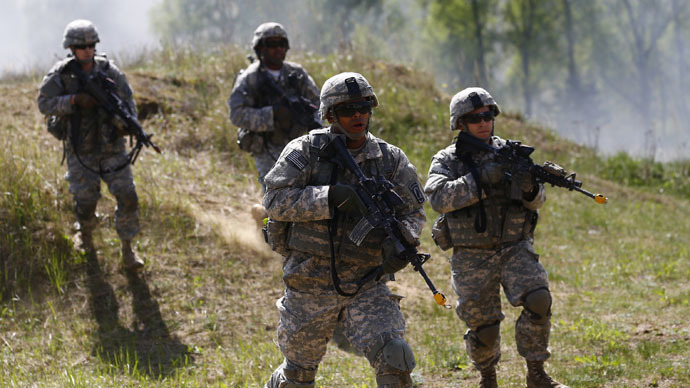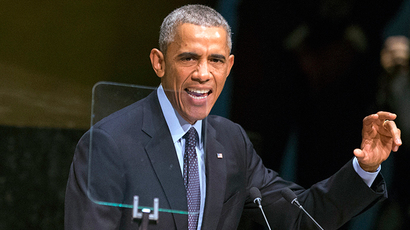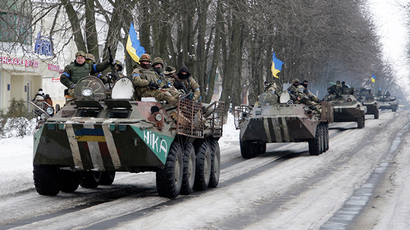Russia-NATO: Moscow mission sums up 25 years of myths vs reality

Russia’s permanent mission to NATO has prepared a report summing up complicated relations between the alliance and Moscow over the last 25 years, which differs substantially from what the report calls NATO’s simplified “black and white” picture.
The ‘Russia-NATO: facts and myths’report investigates in detail the difference between NATO’s declared efforts to maintain peace and security in Europe and historic facts, which expose the alliance’s reason for existence: to confront Russia as its primary adversary.
Soviet Union’s retreat from Europe
Starting from the late 1980s, Moscow gradually withdrew troops and military hardware from Europe, simultaneously degrading its military potential in general. At the time NATO member states regarded this unilateral process as a natural containment of Russia.
While Moscow withdrew over 800,000 personnel and tens of thousands of tanks, APCs, cannons and military aircraft from the former Warsaw Pact and Baltic states, the political leadership of Western countries “decided to put the stake on ‘a closed architecture’ – NATO enlargement eastwards to the detriment of the development and consolidation of common European institutions,” the report says.
The leaders of NATO member states “reassured the Soviet authorities that they don’t have any plans to expand eastwards.” Later on, with more and more Eastern European states joining NATO “we received assurances that membership of the Central and Eastern European countries in NATO would improve relations with Moscow.”
“These affirmations turned out to be a myth. On the contrary, today the security policy of these countries is based on the idea that there is a need for their special protection.”
Since the fall of the Soviet Union, NATO welcomed 12 new members. Hungary, the Czech Republic, and Poland joined the alliance in 1999. Estonia, Latvia, Lithuania, Slovenia, Slovakia, Bulgaria, and Romania - in 2004. In 2009, the alliance accepted Croatia and Albania.
‘Cold War DNA’: NATO at Russia’s gate
Euro-Atlantic security is currently in crisis, maintains the report, due to the fact that NATO “cannot fully adapt to the real security needs.” This stems from the NATO’s initial “Genetic code” preserved after the Cold War was over.
READ MORE: Washington started all modern military conflicts - Russia’s General Staff
The NATO membership of former socialist countries and former Soviet republics in Eastern Europe has only “aggravated the syndrome of ‘front-line states’ and created preconditions for a new Iron Curtain – from the side of the West.”
The report says that the military tensions on Russian borders “weakens rather than strengthens” the security of the new NATO member states, and also increases the danger of “spiraling into a new arms race.”
NATO has brought its military infrastructure “directly to the Russian borders,” which means that in case of a military conflict the European part of Russia “will be open to attacks by the air forces of NATO member states.”
Over the last year an unprecedented increase in NATO military activity has been registered near the borders of Russia. This is accompanied by provocative statements about the need to ‘deter’ Russia and an aggressive anti-Russian propaganda campaign in Western mass-media.
READ MORE: NATO activity near Russian borders increased by 80% – General Staff
The alliance justified this by the crisis in Ukraine, which has evolved into a full-fledged civil war with thousands of victims. Some NATO member states including the United States have sent their military instructors to train the Kiev authorities’ troops.
READ MORE: Putin: Ukraine army is NATO legion aimed at restraining Russia
“Obviously, this is not helping to reduce tensions,” the report says, noting that there is no real alternative to “mutually beneficial and wide cooperation” between Russia and NATO on the “basis of equality, pragmatism and respect” for the interests of each other.
“Russia is not interested in the confrontation spiraling into a new Cold War.”
Russia and common security in Europe
The report gave a reminder that Russia has “repeatedly joined multilateral efforts for the sake of strengthening common security,” deploying its peacemakers to a number of conflict zones in Europe.
In this regard NATO’s aggression against the Federal Republic of Yugoslavia in 1999 “under the far-fetched pretext of protecting the Albanian population” aggravated the security situation in central Europe. It brutally violated the UN Charter and a number of international treaties, as well as norms of humanitarian law, as the Alliance carried out bombings of peaceful Yugoslav towns and villages for 78 days.
As a result of NATO aggression against Yugoslavia, the country ceased to exist. It fractured into a number of states, most of which have already become members of the alliance.
Dismantling the legacy of the Cold War
Russia played a vital role in dismantling the legacy of the Cold War, primarily by expressing its “firm commitment to arms control instruments,” in the first place through preservation of the Treaty on Conventional Armed Forces in Europe (CFE) signed in 1990.
As the years passed, it turned out that NATO member states never intended to do the same or at least fulfill their international obligations in accordance with treaties already signed with Russia. For Moscow, the CFE became obsolete after the Alliance accepted more members from Eastern Europe.
Russia had to suspend participation in the Treaty on December 12, 2007, sparking fierce criticism from NATO member states which never even ratified the latest version of the document, the Adaptation of the CFE Treaty, ratified by Russia in 2003.
US global missile defense system in Europe
For 15 years Russia has been consistently opposing plans to deploy the American anti-missile complexes to Europe next to Russia’s borders, “which directly affects the security interests” of Russia.
Because the implementation of such plans is actively ongoing, the report points out that for the US and its NATO allies the ballistic missile defense (BMD) system has become a “tool to ensure its own military superiority in the first place,” without taking into consideration the security interests of other countries.
“Taking into account the continuous build-up of the US/NATO BMD system in Europe the “window of opportunity” for compromise is steadily closing up,” the report says.
Initially, deployment of BMD systems in Europe was a measure taken over worries about Iran’s nuclear program. Yet despite progress being made concerning nuclear talks with Iran, Russia says US and EU officials are trying to “dream up” new reasons to deploy the US missile shield in Europe.
READ MORE: Tehran threat? Russia questions US, EU motives behind missile shield in Europe
NATO has already deployed a BMD installation in Poland and is regularly dispatching warships equipped with BMD interceptor radars and missiles close to Russian borders.
Russia and frustrated European Security Treaty
In June 2008, Russia proposed to jointly elaborate a European Security Treaty, another move to step away from the Cold War legacy. The document was supposed to legally fix the principle of indivisibility of security, which means that “no state can strengthen its security at the expense of other states.”
“Unfortunately, Western partners haven’t expressed their readiness to discuss our proposals substantively,” the report says.
Russia’s 2010 proposal for a more effective joint effort to protect “intertwined” NATO and Russia security against common security challenges, including missile defense, was ignored as well.
NATO’s military expenditure compared to Russia’s
The total military budget of NATO member states exceeds $US 1,023 trillion (of which $735 billion is the US’s), whereas Russia spends about $60 billion, or 17 times less.
“Russia ranks as the world’s 40th in terms of proportion of defense expenditures to the length of state borders.”
Russia’s military budget is designed to replace obsolete military hardware and compensate for the underfinancing of its army in the 1990s. The report highlights the fact that Moscow does not deploy its nuclear potential beyond its borders and does not possess a huge web of military bases around the world and is not seeking “assured military superiority.”
In conclusion, the report’s authors express hope that “this fact sheet will allow an impartial observer to understand the history of relations between Russia and NATO and to come to conclusions based on the real facts and not their interpretations.”













